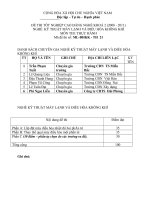PASSAGE 21
Bạn đang xem bản rút gọn của tài liệu. Xem và tải ngay bản đầy đủ của tài liệu tại đây (42.33 KB, 2 trang )
PASSAGE 21
Twenty-three million years ago, a giant carnivore larger than any modern-day lion or polar bear stalked
sub-Saharan Africa, according to the fossils of a previously undiscovered species that spent decades in a
museum drawer at the National Museums of Kenya. The fossils were originally found in Kenya decades
ago, but at that time researchers were searching for ancient apes, so the fossils were put aside.
The skull of the fossil is comparable to that of a rhinoceros, and given its size and giant sharp teeth, the
carnivore was at the head of its food chain. Researchers estimate that it weighed 1.6 tons and could prey
on large herbivores akin to today’s elephant and hippopotamus. Its canine teeth and molars would have
been able to tear flesh and crack bones easily.
The researchers dubbed the newly discovered species Simbakubwa kutokaafrika, which is Swahili for
“big lion coming from Africa.” But it’s not a close relative of lions, other big cats or even mammalian
carnivores that roam the Earth today. Instead, Simbakubwa was part of the hyaenodonts, an extinct group
of mammalian carnivores that lived in Africa.
After the extinction of dinosaurs, they enjoyed a 45 million-year reign as the key predators. Additionally,
tectonic plates shifted, allowing Simbakubwa to cross a landbridge into Eurasia and flourish on other
continents, as well. And even though they lived for millions of years, they went extinct between 15
million and 18 million years ago.
“We don’t know exactly what drove hyaenodonts to extinction, but ecosystems were changing quickly as
the global climate became drier. The gigantic relatives of Simbakubwa were among the last hyaenodonts
on the planet,” said Matthew Borths, study author and curator of the Division of Fossil Primates at Duke
University. Nancy Stevens, study co-author and professor in the Heritage College of Osteopathic
Medicine at Ohio University, noted in a statement that “This is a pivotal fossil, demonstrating the
significance of museum collections for understanding evolutionary history. Simbakubwa is a window into
a bygone era. As ecosystems shifted, a key predator disappeared, heralding Cenozoic faunal transitions
that eventually led to the evolution of the modern African fauna.”
(Adapted from )
Question 1. The passage primarily concerns which of the following?
A. The characteristics of an ancient species called hyaenodonts.
B. The study of fossils and ancient dinosaurs in Kenya.
C. The largest and oldest living carnivore.
D. The discovery of an ancient carnivore’s fossils in Africa.
Question 2. What can be inferred from the first paragraph?
A. The fossils did not attract scientists or reasearcher’s attention for years.
B. Reasearchers in Kenya ignored the fossils because they were incompetent.
C. The fossils are a relatively recent discovery.
D. Ancient apes lived in Kenya in the distant past, along with the fossils.
Question 3. The word “akin” in the second paragraph most likely means ___________.
A. hostile
B. dangerous
C. similar
D. independent
Question 4. The word “it” in the second paragraph refers to __________.
A. A rhinoceros
B. The skull
C. Food chain
D. The carnivore
Question 5. It can be inferred from what Matthew Borths said in the last paragraph that __________.
Page 1
A. Drier global climate had almost no effect on ecosystems.
B. The gigantic relatives of Simbakubwa were last seen in Africa.
C. Researchers have determined the exact reason why hyaenodonts went extinct.
D. Shifting ecosystems probably contributed to the extinction of hyaenodonts.
Question 6. The word “flourish” in the fourth paragraph most likely means ___________.
A. dominate
B. thrive
C. evolve
D. bloom
Question 7. Which of the following is TRUE about Simbakubwa?
A. They originated in areas outside the continent of Africa
B. They reigned over many species, including dinosaurs, for 45 million years.
C. They bear little relation to modern-day big cats or mammalian carnivores.
D. They suffered from negative effects caused by the movement of tectonic plates.
Question 8. Which of the following statements can be inferred from the passage?
A. The species that the newly discovered fossils in Kenya belong to, which is a close relative of
modern-day lions, was one of the largest carnivores ever to walk the Earth.
B. The fossils found in Kenya plays an instrumental role in helping researchers understand more about
the evolution of species.
C. Thanks to the discovery of the fossils, researchers at Kenya can now work on determining how
hyaenodonts went extinct.
D. It is possible that the true ancestor of modern-day big cats may never be found due to the rapid
changes of global climate and ecosystems.
ĐÁP ÁN
1-D
2-A
3-C
6-B
7-C
8-B
4-D
5-D
Page 2









